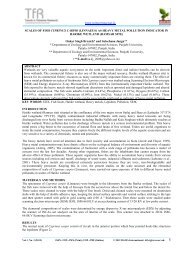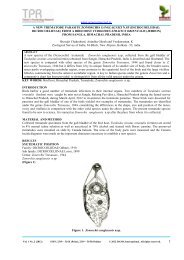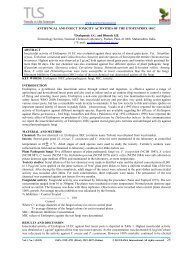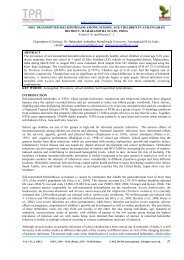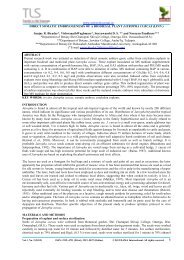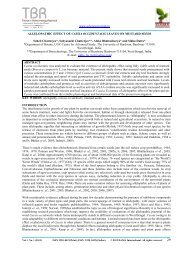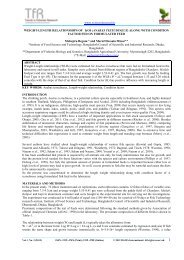STUDY OF SEED BORNE FUNGI OF ... - sciencejournal.in
STUDY OF SEED BORNE FUNGI OF ... - sciencejournal.in
STUDY OF SEED BORNE FUNGI OF ... - sciencejournal.in
You also want an ePaper? Increase the reach of your titles
YUMPU automatically turns print PDFs into web optimized ePapers that Google loves.
www.<strong>sciencejournal</strong>.<strong>in</strong><br />
<strong>STUDY</strong> <strong>OF</strong> <strong>SEED</strong> <strong>BORNE</strong> <strong>FUNGI</strong> <strong>OF</strong> DIFFERENT LEGUMES<br />
Narayan M. Ghangaokar 1 and Ayodhya D. Kshirsagar 1*<br />
1 C.T.Bora College, Shirur (Ghodnadi), Tal-Shirur, Dist- Pune P<strong>in</strong>- 412210<br />
(*E-mail: drayodhya11@gmail.com nghanu@gmail.com)<br />
ABSTRACT<br />
The study aims at identify<strong>in</strong>g legumes seed borne fungi associated with Pisum sativum L., Macrotyloma uniflorum<br />
(Lam) Verdc., Lens cul<strong>in</strong>aris Medik., Phaseolus vulgaris L., Vigna unguiculata L.Walp., Cajanus cajan L. Millsp.,<br />
Cicer ariet<strong>in</strong>um L. were collected from Shirur tahashil (Pune). The legume seed born fungi was screened by us<strong>in</strong>g<br />
blotter plate method from selected untreated and treated seeds. The untreated seeds were found to be associated with<br />
highest number of seed borne fungi. The fungi isolated from these seeds are Alternaria alternata, Chaetomium spp.,<br />
Penicillium citr<strong>in</strong>um, Aspergillus niger, A. fumigatus, A. flavus, Rhizopus nigricans, Fusarium oxysporum, F.<br />
moniliform , F. solani, Chaetomium sp, Curvularia lunata, Macrophom<strong>in</strong> sp, Monilia sp., Penicillium sp., Rhizoctonia<br />
sp, Trichoderma etc.<br />
KEY WORDS: blotter plate method, legumes, seed born fungi<br />
INTRODUCTION<br />
Seed is the most important <strong>in</strong>put for crop production. Pathogen free healthy seed is urgently needed for desired plant<br />
populations and good harvest. Many plant pathogens are seed-borne, which can cause enormous crop losses; reduction<br />
<strong>in</strong> plant growth and productivity of crops (Williams and McDonald, 1983; Kubiak and Korbas, 1999; Dawson and<br />
Bateman, 2001; Islam et al., 2009).<br />
Legume seeds have comparatively higher prote<strong>in</strong> content than non-legume plant. The high prote<strong>in</strong> content makes them<br />
desirable crops <strong>in</strong> agriculture. The seeds of legumes are second only to cereals as the most important source of food for<br />
humans and animals (National Academy of Sciences, 1979). All varieties of pulses are excellent source of easily<br />
digestible prote<strong>in</strong>. But there are several factors which are responsible for their low production. Among them, diseases<br />
play an important role (N<strong>in</strong>e, 1986 and Pal, 1996). Numerous examples exist <strong>in</strong> literature for the <strong>in</strong>ternational and<br />
national spread of plant diseases as a result of the importation of seeds that were <strong>in</strong>fected or contam<strong>in</strong>ated with<br />
pathogens (Agarwal, 1976). Seed-borne diseases have been found to affect the growth and productivity of crop plants<br />
(Kubiak and Korbas, 1999; Weber et al., 2001; Dawson and Bateman, 2001). Presence or absence of seed borne fungi<br />
on seed surface is one of the important aspects that determ<strong>in</strong>e the quality of seed.<br />
The present <strong>in</strong>vestigation was undertaken to f<strong>in</strong>d out the seed borne fungi associated with the seeds of selected<br />
legumes. Consider<strong>in</strong>g the nutritional, agronomical and <strong>in</strong>dustrial value of pulses and yield of legumes, the present study<br />
aims to <strong>in</strong>vestigate seed-borne fungi associated with Pisum sativum L., Macrotyloma uniflorum (Lam) Verdc., Lens<br />
cul<strong>in</strong>aris Medik., Phaseolus vulgaris L., Vigna unguiculata L. Walp., Cajanus cajan L. Millsp., Cicer ariet<strong>in</strong>um L.<br />
from Shirur Tahsil (Pune, M.H. India).<br />
MATERIALS AND METHOD<br />
Plant Materials:<br />
Pisum sativum L., Macrotyloma uniflorum (Lam) Verdc., Lens cul<strong>in</strong>aris Medik., Phaseolus vulgaris L., Vigna<br />
unguiculata L.Walp., Cajanus cajan L. Millsp., Cicer ariet<strong>in</strong>um L. All legume seed samples were collected from<br />
different localities of Shirur Tahsil (Pune, M.H. India).<br />
Seed Borne fungi analysis:<br />
Detection of seed borne fungi from selected legume seeds was done by blotter paper method as recommended by<br />
International Seed Test<strong>in</strong>g Association (1966), de Tempe (1953), Neergard (1973) and Agrawal (1976). For the<br />
standard blotter method, untreated seeds and seeds after treatment with 0.1% Sodium hypochlorite for 10 m<strong>in</strong>utes were<br />
placed on three layers of moistened blotter, 10 seeds per petri dish. The plates were then <strong>in</strong>cubated <strong>in</strong> B.O.D <strong>in</strong>cubator<br />
at 25± 2˚C for 8 days under 12 hrs alternat<strong>in</strong>g cycles of light and darkness. Thus, the exposed seeds were exam<strong>in</strong>ed on<br />
the 9 th day under stereo b<strong>in</strong>ocular microscope for the presence of seed borne fungi. The fungi found on the seeds were<br />
recorded and percentage of seeds <strong>in</strong>fested and germ<strong>in</strong>ation of seeds with different fungi was calculated. The isolated<br />
fungi were identified with the help of the keys, monograph and literature provided by Raper and Fennell, (1965);<br />
Booth, (1971); Ellis, (1971); Barnett and Hunter (1972). Untreated seeds were used as controls. All experiments were<br />
carried out <strong>in</strong> triplet set.<br />
Volume 2 Issue 1 (2013) ISSN: 2319–4731 (Pr<strong>in</strong>t); 2319–5037 (Onl<strong>in</strong>e) © 2013 DAMA International. All rights reserved. 32
www.<strong>sciencejournal</strong>.<strong>in</strong><br />
RESULTS AND DISSCUSIONS<br />
Seeds play a vital role <strong>in</strong> the production of healthy crops. Healthy seed is the foundation of healthy plant; a necessary<br />
condition for good yields (Diaz et al., 1998).<br />
Table.1 : Seed borne fungi isolated through blotter method from selected seven sampl<strong>in</strong>g legume seeds<br />
Legumes Pisum Macrotyloma Vigna Phaseolus Lens Cajanus Cicer<br />
Fungi<br />
sativum uniforum unguiculata vulgaris cul<strong>in</strong>aris cajan ariet<strong>in</strong>um<br />
Un T Un T Un T Un T Un T Un T Un T<br />
Aspergillus flavus L<strong>in</strong>k + + + + + + + + + + + + +<br />
Aspergillus fumigatus - - - - + - + - - - + - + -<br />
Fresenius<br />
Aspergillus niger van + + + + + + + + + + + + + +<br />
Tieghem<br />
Aspergillus terreus Thom + + - - - - - - + - + + + -<br />
Aspergillus nidulans<br />
- - - - + - + - - - - - - -<br />
(Eidam) W<strong>in</strong>ter<br />
Alternaria longipes Mason - - - - - - - - - - + + - -<br />
Alternaria alternata Keissler + - + - + - - - + - - - + +<br />
Acremonium sp. + - - - - - - - - - + - - -<br />
Botrytis sp. - - - - + + - - - - + - + -<br />
Cladosporium sp - - - - + - - - - - - - + -<br />
Chaetomium globosum + - - - + - - - - - - - - -<br />
kuhze ex steud<br />
Chaetomium sp - - - - - - + - - - + - + -<br />
Curvularia lunata Boedijn - - - - + - + + - - + - + +<br />
Drechslera sp. - - - - + - + - - - + + - -<br />
Fusarium moniliforme - - - - + + - - + - - - + +<br />
Sheldon<br />
Fusarium solani (Mart.) + - - - - - + + + + + + - -<br />
Sacc.<br />
Fusarium oxysporium Schle. - - - - + + + - - - + - + +<br />
ex Fries<br />
Fusarium equiseti (Corda) - - + - - - + - - - - - - -<br />
Sacc.<br />
Helm<strong>in</strong>thosporium sp. - - + - + - - - - - + - - -<br />
Humicola sp. + - + - - - - - + - - - - -<br />
Macrophom<strong>in</strong>a phaseol<strong>in</strong>a + - - - - - - - - - + - + +<br />
(Tassi)<br />
Monilia sitophila Sacc. - - - - + - - - + + - - - -<br />
Mycelia sterilia - - + - - - - - - - + - + +<br />
Mucor hiemalis corti. + - - - + + - - + - - - + -<br />
Mucor racemosus Fresenius - - - + - - + + - - + + - -<br />
Nigrospora oryzae (Berk. & + - - - - + + - - + - - - -<br />
Br.) Petch<br />
Penicillium chrysogenum - - - - - + - - - - - - + -<br />
Thom.<br />
Penicillium citr<strong>in</strong>um Thom - - - - + + - - + - - - - -<br />
Penicillium sp. + + - - - - + + - + - - + +<br />
Phoma sp - - + - + - - - - - - - + -<br />
Pythium sp - - - - - - + + - - - - - -<br />
Rhizoctonia bataticola + - - - - - - + - - + + + +<br />
(Taub) Butler<br />
Rhizopus nigricans Ehrenb + + - + + + + + + + + + + -<br />
Rhizopus nodosus<br />
- - - - - - + - - + + + + +<br />
Namyslowski<br />
Sclerotium sp - - + - - - - - - - - - + -<br />
Scopularopsis sp. - - + - - - + - - - - - - -<br />
Trichoderma hamatum - - - - + + - - - - - - - -<br />
(Bon.) Ba<strong>in</strong>.<br />
Trichoderma viridae Persoon + - + - - - + - + - + - + +<br />
ex Fries<br />
Verticillium sp - - + + + - - - -- - - - -<br />
Volume 2 Issue 1 (2013) ISSN: 2319–4731 (Pr<strong>in</strong>t); 2319–5037 (Onl<strong>in</strong>e) © 2013 DAMA International. All rights reserved. 33
www.<strong>sciencejournal</strong>.<strong>in</strong><br />
They are carriers of some important seed-borne diseases caused by microorganisms which results <strong>in</strong> considerable losses<br />
<strong>in</strong> yields. Many fungal pathogens, some of which are seed transmitted, often reduce the germ<strong>in</strong>ation ability or kill the<br />
<strong>in</strong>fected plants or substantially reduce the productive capacity. Therefore, control of seed-borne fungi is extremely<br />
important and the damag<strong>in</strong>g effects can be relieved through <strong>in</strong>tegrated approaches (Vaidehi, 2002). Altogether 40<br />
species of fungi were isolated from seven samples of legume seeds dur<strong>in</strong>g present study (Table1). Among the samples<br />
studied the fungi, Aspergillus nidulans, A.niger, A. fumigates, A. flavus, Alternaria alternate, Acremonium sp.,<br />
Chaetomium sp., Rhizopus nigricans Fusarium moniliforme, F. solani, F. oxysporum, Macrophom<strong>in</strong>a phaseol<strong>in</strong>a,<br />
Botrytis sp., Cladosporium, Helm<strong>in</strong>thosporium sp. Curvularia, Drechslera, Humicola,, Penicillium chrysogenum,<br />
Mucor racemosus, Mucor hiemalis Phoma, Monilia sitophila, Pythium, Trichoderma viridae, Trichoderma hamatum,<br />
Nigrospora oryzae, Rhizoctonia bataticola, Sclerotium sp and Verticillium sp etc were reported.<br />
Un: Untreated seeds, T: treated seeds<br />
Figure1: Percentage of seed germ<strong>in</strong>ation results of seven selected sampl<strong>in</strong>g legumes seeds<br />
In this study significant number of fungi was isolated from these seed samples. The untreated seeds were found to be<br />
associated with highest number of seed borne fungi. It was found that Cicer ariet<strong>in</strong>um L. seeds yielded the highest<br />
number of fungal species followed by Cajanus cajan L. Millsp., Vigna unguiculata L.Walp., Phaseolus vulgaris L.,<br />
Pisum sativum L., Lens cul<strong>in</strong>aris Medik. and Macrotyloma uniflorum (Lam) Verdc., seeds showed the least number of<br />
fungal species. That is <strong>in</strong> order to, Cicer ariet<strong>in</strong>um L.> Cajanus cajan L. Millsp. > Vigna unguiculata L.Walp.><br />
Phaseolus vulgaris L.> Pisum sativum L.> Lens cul<strong>in</strong>aris Medik.> Macrotyloma uniflorum (Lam) Verdc. dur<strong>in</strong>g<br />
present study.<br />
The most common fungi were Aspergillus flavus, Aspergillus niger Alternaria alternate, Fusarium moniliforme,<br />
Rhizopus nigricans and Trichoderma viridae were common <strong>in</strong> all selected seed samples. In Cicer ariet<strong>in</strong>um L. high<br />
<strong>in</strong>cidence of Aspergillus niger Fusarium moniliforme, Rhizopus nigricans and Trichoderma virida was found when<br />
compared to other. Many fungal species viz., Alternaria alternata, Aspergillus terrus, A. flavus, A. fumigatus, A. niger,<br />
Botrytis sp, Cladosporium, Curvularia lunata, Fusarium solani, F. moniliforme, F. oxysporum, Macrophom<strong>in</strong>a<br />
phaseol<strong>in</strong>a, Penicillium notatum, Rhizoctonia sp., and Rhizopus nigricans etc has been reported from Cicer ariet<strong>in</strong>um<br />
L.. Similar observation recorded by Ahmad et al., 1993. The most common seedbrone fungi on Phaselous vulgaris<br />
were Aspergillus niger, A. flavus, Fusarium oxysporum, Botrytis sp, Chaetomium sp, Penicillium notatum., Rhizopus<br />
spp., Cladosporium sp. and Trichothecium.<br />
The fungi isolated from Lens cul<strong>in</strong>aris Medik. treated seeds were Fusarium moniliforme, Alternaria alternata, Mucor<br />
hiemalis, Chaetomium sp, Penicillium citr<strong>in</strong>um, Aspergillus niger, A. flavus, A .terreus and Nigrospora sp. F.<br />
moniliforme, A. alternata, M. hiemalis, Chaetomium spp., and A. Niger were common <strong>in</strong> all samples while P. citr<strong>in</strong>um,<br />
A. flavus, A. terreus and Nigrospora spp., were only isolated from untreated seed. (Muhammad Arshad Hussa<strong>in</strong> et al.,<br />
2007). Richardson, (1979) gave a list of seed-borne diseases of lentil, accord<strong>in</strong>g to which Botrytis spp., and F.<br />
oxysporum were isolated from lentil seed from Czechoslovakia and Uromyces fabae from debris mixed with seed from<br />
Volume 2 Issue 1 (2013) ISSN: 2319–4731 (Pr<strong>in</strong>t); 2319–5037 (Onl<strong>in</strong>e) © 2013 DAMA International. All rights reserved. 34
www.<strong>sciencejournal</strong>.<strong>in</strong><br />
India. Arun and Mathew (1991) studied mycoflora of pigeon pea seeds and isolated R. nigricans, A. niger, A.<br />
fumigatus, A. alternata, Macrophom<strong>in</strong>a phaseol<strong>in</strong>a, F. pallidoroseum, Chaetomium spp., Drechslera sp. and Phoma sp.<br />
Dur<strong>in</strong>g present study, contam<strong>in</strong>ated seeds result <strong>in</strong> poor germ<strong>in</strong>ation and poor seedl<strong>in</strong>g vigor, result<strong>in</strong>g <strong>in</strong> an unhealthy<br />
crop. Percentage of seed germ<strong>in</strong>ation results of seven selected sampl<strong>in</strong>g legumes seeds were Cicer ariet<strong>in</strong>um L.<<br />
Cajanus cajan L. Millsp. < Vigna unguiculata L.Walp.< Phaseolus vulgaris L.< Pisum sativum L.< Lens cul<strong>in</strong>aris<br />
Medik.L< Macrotyloma uniflorum (Lam) Verdc.(Figure 1). Fungus associated with seeds because deterioration of seed<br />
quality, affect viability and reduces germ<strong>in</strong>ation (Srivastava and Gupta, 1981). Control of seed-borne fungi will<br />
<strong>in</strong>crease percentage of seed germ<strong>in</strong>ation and gra<strong>in</strong> yield (DGISP, 1985). Umechuruba and Nwachukwu, (1994);<br />
Umechuruba and Nwachukwu, (1997) also reported significant reduction <strong>in</strong> seed germ<strong>in</strong>ation, seedl<strong>in</strong>g emergence and<br />
low seed and tuber yield of African yam bean caused by these important seed-borne fungi, as well as reduction <strong>in</strong><br />
nutritional qualities of the seeds.<br />
ACKNOWLEDGEMENT<br />
Dr. Narayan M. Ghangaokar and Dr. Ayodhya D. Kshirsagar is grateful to the Pr<strong>in</strong>cipal, Prof. N. S. Nikam, C.T. Bora<br />
College, Shirur. Pune, P<strong>in</strong> 412210.<br />
REFERENCES<br />
Agrawal P. K. (1976). Identification of suitable seed storage places <strong>in</strong> India on the basis of temperature and relative<br />
humidity condition. Seed Res. 4(1):6-11.<br />
Ahmad I. S. Iftikhar and Bhutta A.R. (1993). Seed borne microorganism <strong>in</strong> Pakistan. A checklist 1991. Pakistan<br />
Agricultural Research Council, Islamabad, Pakistan. Pp 32.<br />
Arun A. and Mathew D.S. (1991). Seed mycoflora of pigeon pea. Acta Botanica Indica. 19(1): 102-103.<br />
Barnett H.L. and Hunter B.B. (1972). I/lustrated genera of imperfect fungi (3Td ) Ed; Burgess Publish<strong>in</strong>g Company,<br />
M<strong>in</strong>nesota. Pp 24.<br />
Booth C. (1971). The genus Fusarium. Commonwealth Mycological Institute, Kew, Surrey, England. Pp 237.<br />
de Tempe J. (1953). The blotter method of seed health test<strong>in</strong>g. Proc. ISTA. 26: 133-151.<br />
Dawson W.A.J.M. and Bateman G.L. (2001). Bateman.Fungal communities on roots of wheat and barley and effects<br />
of seed treatments conta<strong>in</strong><strong>in</strong>g fluqu<strong>in</strong>conazole applied to control take-all. Plant Pathology, 50: 5-82.<br />
DGISP (1985). Seed health. Food production, March<br />
Diaz C., Hossa<strong>in</strong> M., Bose M. L., MerceaS and Mew T.W. (1998). Seed quality and effect on rice yield: f<strong>in</strong>d<strong>in</strong>gs<br />
from farmer sparticipatory experiment <strong>in</strong> Central Luzon,Philipp<strong>in</strong>es. J. Crop. Sci. 23(2):111-119.<br />
Ellis M.B. (1971). Dematiaceous hypomycetes. Cab International, Kew, Surrey, England. Pp 608.<br />
International Seed Test<strong>in</strong>g Association (1966). International rules for seed test<strong>in</strong>g. Proc. Int. Seed Asso. 32:565-589.<br />
Islam S.M.M., Masum M. M. I. and Fakir M. G. A. (2009). Prevalence of seed-borne fungi <strong>in</strong> sorghum of different<br />
locations of Bangladesh. Scientific Research and Essay. 4(3):175-179<br />
Kubiak K. and Korbas M. (1999). Occurrence of fungal diseases on selected w<strong>in</strong>ter wheat cultivars. Postepy<br />
Ochronie Rosl<strong>in</strong>, 39 (2): 801-804<br />
Muhammad A. H., Tariq M., Ulhaque M.I and Muhammad Z.K. (2007). Mycoflora associated with lentil (Lens<br />
esculenta Moench) seeds from five localities of Punjab, Pakistan. Pak. J. Bot., 39(3): 903-906.<br />
National Academy of Sciences (1979). Genetic vulnerability of major crops. Wash<strong>in</strong>gton, D C. Tropical legumes:<br />
resources for the future. Wash<strong>in</strong>gton, DC.<br />
Neergard P. (1973). Detection of seed borne pathogens by culture tests. Seed Sci. and Technol. 1:217-254.<br />
N<strong>in</strong>e Y.L. (1986). Opportunities for research on diseases of pulse crops. Indian Phytopathology,. 39(3):333-342.<br />
Pal M. (1996). Pulse disease scenario. Indian Phytopathol. 49 (2):129-131.<br />
Raper K. B. and Fennell O.J. (1965). The genus Aspergillus. The Williams and Wilk<strong>in</strong>s Co. Baltimore. Pp 686.<br />
Richardson M.J. (1979). An annotated list of seed-borne diseases. Commonwealth Mycol. Inst. Kew, Surrey,<br />
England.<br />
Umechuruba C.I. and Nwachukwu E.O. (1994). Efficacy of certa<strong>in</strong> fungicides aga<strong>in</strong>st seedborne fungi of African<br />
yam bean seeds. I. J. Pest Manag. 4 (2): 126-131.<br />
Nwachukwu E.O. and Umechuruba C. I. (1997). Changes <strong>in</strong> nutritional values of African yam beanseeds due to<br />
seed- borne fungi. G. J Pure Appl. Sci. 3 (2):141-147.<br />
Vaidehi B.K. (2002). Seed mycoflora of sunflower - a perspective. Frontiers <strong>in</strong> Micro Biotech Plant pathol., 25-40.<br />
Weber R. B., Hrynczuk B., Runowska Hrynczuk and Kita B (2001). Influence of the mode of tillage on diseases of<br />
culm base <strong>in</strong> some w<strong>in</strong>ter wheat varieties, oats, and spr<strong>in</strong>g wheat. J. Phytopathol. 149: 185-188.<br />
Volume 2 Issue 1 (2013) ISSN: 2319–4731 (Pr<strong>in</strong>t); 2319–5037 (Onl<strong>in</strong>e) © 2013 DAMA International. All rights reserved. 35




